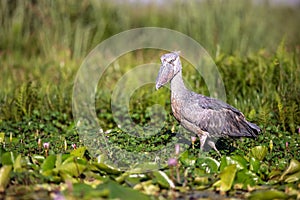- Stock Photography: SHOEBILL STORK by Hari865
- Price: 1$
- Size Facebook: 1702 x 630 px
- Size Twitter: 1500 x 500 px
- Size LinkedIn: 1128 x 191 px
More Facebook, Twitter and LinkedIn Cover Photos
Cover photo info
- Photo title: Shoebill Stork
- Author: Hari865
- Cover photo description:
- Shoebill (Balaeniceps rex) type of bird Shoebill is a carnovore bird Average life span in the wild is 35 yearsAverage life span in captivity is about 50 yearsShoebill weighs around 11 pounds (females) and 12 pounds (males)IUCN Red list status is VUNERABLE, Current population trend is decreasingShoebill is unique because of its foot-long bill that resembles a Dutch clog. The bill is Tan with brown splotches, The bill is five inches wide and has sharp edges and a sharp hook on the end. Its specialized bill allows the shoebill to grab large prey, including lungfish, tilapia, eels, and snakes. It even snacks on baby crocodiles and Nile monitor lizards. At first glance, shoebills don’t seem like they could be ambush predators. Reaching up to five feet tall with an eight-foot wingspan, shoebills have yellow eyes, gray feathers, white bellies, and a small feathered crest on the back of their heads. They also have long, thin legs with large feet Feet that are ideal for walking on the vegetation in the freshwater marshes and swamps they inhabit in East Africa, from Ethiopia and South Sudan to Zambia. Shoebills can stay motionless for hours The birds practice a hunting technique called “collapsing,” which involves lunging or falling forward on their prey. Shoebills are in a family all their own, though they were once classified as storks. Shoebills sometimes engage in bill-clattering, a sound made as a greeting and during nesting They keep cool with a technique called gular fluttering—vibrating the throat muscles to dissipate heat
- Image ID:267572332
- Views:0
- Downloads:0
Keywords for Facebook, Twitter and LinkedIn timeline photos
shoebill
stork
uganda
bird
animal
nature
grass
beak
prairie
meadow
wetland
grassland
shorebird
waterbird
balaeniceps
carnovore
weighs
females
malesiucn
status
vunerable
population
foot
long
dutch
clog
brown
splotches
sharp
hook
lungfish
tilapia
eels
snakes
snacks
baby
crocodiles
monitor
shoebills
ambush
predators
feet
tall
eight
foot
wingspan
yellow
eyes
gray
feathers
bellies
feathered
crest
long
legs
ideal
walking
vegetation
freshwater
marshes
swamps
inhabit
africa
ethiopia
sudan
motionless
hunting
technique
lunging
bill
clattering
sound
greeting
cool
gular
fluttering
vibrating
throat
muscles
nesting
clog
snakes
predators
storks














